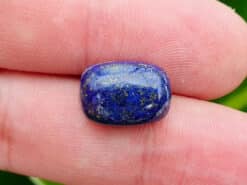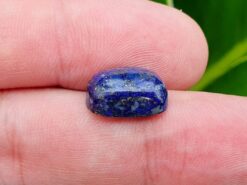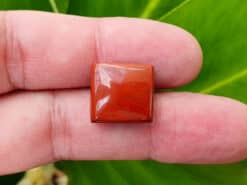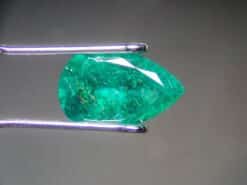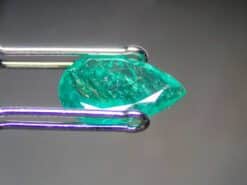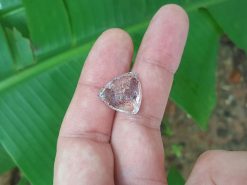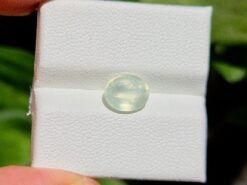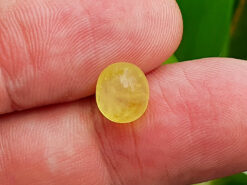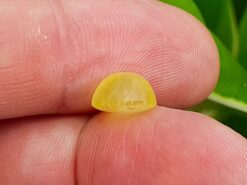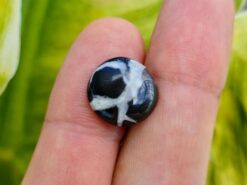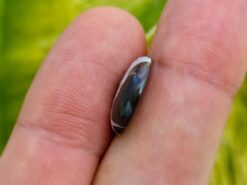Cavansite in matrix

Buy natural gemstones in our shop
Blue cavansite crystal stone meaning and healing properties
Cavansite, whose name originates from its chemical composition—calcium vanadium silicate—is a captivating blue cavansite crystal stone typically found as a secondary mineral in basaltic and andesitic rocks. It frequently occurs alongside various zeolite minerals, making it a sought-after specimen for collectors. Its eye-catching hue, usually a vivid and rich blue, contributes to the unique allure of this somewhat rare mineral.
First discovered in 1967 in Malheur County, Oregon, blue cavansite crystal stone is polymorphic with an even rarer mineral called pentagonite. However, cavansite is most commonly sourced from the Pune region in India and the Deccan Traps, a vast igneous province. Though the stone does contain vanadium, it is not typically considered an ore mineral, as its rarity and vibrant color lend it more value as a collector’s piece than as a commercial source.
In terms of physical properties, cavansite is known for its subtransparent diaphaneity, brittle fracture, and vitreous (glassy) luster. It has a hardness of about 3–4 on the Mohs scale—similar to calcite and fluorite—which means it requires gentle handling. Its streak is bluish white, and the density ranges between 2.21 and 2.31. One notable feature of the blue cavansite crystal stone is its tendency to form spherical or “bowtie” crystal clusters, often perched on matrices of associated minerals.
- Members of the apophyllite group.
- Members of the zeolite group, particularly stilbite.
- Babingtonite, Ca2Fe2Si5O14OH.
- Quartz, SiO2.
- Calcite, CaCO3.
- Pentagonite, Ca(VO)Si4O10 · 4(H2O).
- Cleavage: {010} Good.
- Color: Greenish blue, Dark blue.
- Density: 2.21 – 2.31, Average = 2.25.
- Diaphaneity: Subtransparent.
- Fracture: Brittle – Generally displayed by glasses and most non-metallic minerals.
- Hardness: 3-4 – Calcite-Fluorite.
- Luster: Vitreous (Glassy).
- Streak: bluish white.
Cavansite often appears in brilliant blue, spherical crystal clusters, with individual blades sometimes visible under close inspection. In rare cases, the crystals can form unique bowtie-shaped aggregates. This stone’s striking color closely resembles that of its dimorph, pentagonite, though the latter typically shows more elongated, spiky growths. Blue cavansite crystal stone is commonly found on a matrix of zeolites or apophyllites, providing a clear contrast that helps in identification.
Because it forms in limited localities—India being the most notable—cavansite can be challenging to source. Factors such as mine accessibility and the stone’s fragility make it a truly prized addition to any mineral collection. Despite the fact that it contains vanadium, its main appeal lies in its aesthetic and metaphysical value, rather than any industrial application.
Locality and associated elements
Most specimens of this striking mineral come from India, specifically the Pune region. Blue cavansite crystal stone also appears in Oregon, where it was initially discovered. It typically forms in cavities within lava flows, giving it a fascinating geological background. Though often overshadowed by more common minerals, cavansite’s deep blue color and scarcity have cemented its place as a collector’s favorite.
Blue cavansite crystal stone meaning and healing properties benefits
The following section is pseudo scientific and based on cultural beliefs.
This blue cavansite crystal stone is said to enhance emotional clarity and to help facilitate deep spiritual and emotional healing. Many believe it resonates with the element of water, helping to soothe and balance the heart. Its bright energy is also believed to support creative expression, nurturing compassion and love. By encouraging open-mindedness, it may help one connect more deeply with inner intuition.
Sample from India
FAQ
1. Is blue cavansite crystal stone rare?
Yes, it is considered relatively rare. Although its most notable deposits are found in India, the limited quantity of material and the challenges of mining make high-quality specimens scarce and valuable.
2. How should I clean and care for cavansite?
Because of its brittleness and relatively soft hardness (3–4 on the Mohs scale), it’s best to clean blue cavansite crystal stone with a soft brush or cloth and mild soapy water. Avoid harsh chemicals and ultrasonics, as these can damage the crystal.
3. Can cavansite be used in jewelry?
While small cavansite specimens may be set into specialty pieces, it is not commonly used in mainstream jewelry due to its fragility. Most collectors prefer to keep specimens intact and on display rather than subjecting them to everyday wear.
Where does the name “cavansite” come from?
The term “cavansite” is derived from its chemical composition: calcium (Ca), vanadium (V), and silicon (Si). This naming convention highlights the mineral’s most significant elements.
How does cavansite differ from pentagonite?
Though both minerals share the same chemical composition, pentagonite is a dimorph of cavansite and generally exhibits more spiky, elongated crystals. Cavansite, on the other hand, forms more compact, spherical, or bowtie-shaped clusters.



